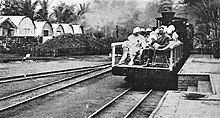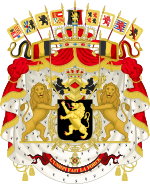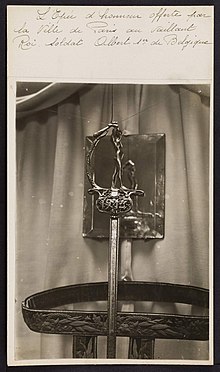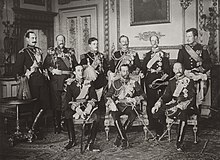Albert I of Belgium
You can helpexpand this article with text translated fromthe corresponding articlein French.(November 2020)Click [show] for important translation instructions.
|
| Albert I | |||||
|---|---|---|---|---|---|
 Albert wearing his characteristicAdrian helmet,c. 1919 | |||||
| King of the Belgians | |||||
| Reign | 23 December 1909 – 17 February 1934 | ||||
| Predecessor | Leopold II | ||||
| Successor | Leopold III | ||||
| Prime Ministers | |||||
| Born | 8 April 1875 Brussels,Belgium | ||||
| Died | 17 February 1934(aged 58) Marche-les-Dames,Namur, Belgium | ||||
| Burial | |||||
| Spouse | |||||
| Issue | |||||
| |||||
| House | Saxe-Coburg and Gotha(until 1920) Belgium(from 1920) | ||||
| Father | Prince Philippe, Count of Flanders | ||||
| Mother | Princess Marie of Hohenzollern-Sigmaringen | ||||
| Religion | Roman Catholicism | ||||
| Signature | |||||
Albert I(8 April 1875 – 17 February 1934) wasKing of the Belgiansfrom 23 December 1909 until his death in 1934.
Albert was born in Brussels as the fifth child and second son ofPrince Philippe, Count of Flanders,andPrincess Marie of Hohenzollern-Sigmaringen,Albert succeeded his uncleLeopold IIto the Belgian throne in 1909. He marriedElisabeth of Bavaria,with whom he had three children.
Albert ruled during an eventful period in thehistory of Belgium,which included the period ofWorld War I(1914–1918), when most ofBelgiumwasoccupied by German forces.Other crucial events of his reign included the adoption of theTreaty of Versaillesin June 1919, the ruling of theBelgian Congoas an overseas possession of Belgium along with theLeague of NationsmandateofRuanda-Urundi,the reconstruction of Belgium following the war, and the first five years of theGreat Depression(1929–1934).
Albert died in a mountaineering accident in eastern Belgium in 1934, at the age of 58, and he was succeeded by his sonLeopold III(r. 1934–1951). He is popularly referred to as theKnight King(Dutch:Koning-Ridder,French:Roi-Chevalier) orSoldier King(Dutch:Koning-Soldaat,French:Roi-Soldat) in Belgium in reference to his role during World War I.
Early life[edit]


 |
| Leopold I |
|---|
|
Children |
| Leopold II |
| Albert I |
| Leopold III |
| Baudouin |
| Albert II |
| Philippe |
Albert Léopold Clément Marie Meinrad was born 8 April 1875 inBrussels,the fifth child and second son ofPrince Philippe, Count of Flanders,and his wife,Princess Marie of Hohenzollern-Sigmaringen.Prince Philippe was the third (second surviving) son ofLeopold I(r. 1831–1865), the firstKing of the Belgians,and his wife,Louise-Marie of France,and the younger brother ofKing Leopold II of Belgium(r. 1865–1909). Princess Marie was a relative of KaiserWilhelm II of Germany(r. 1888–1918), and a member of the non-reigning, Catholic branch of theHohenzollernfamily. Albert grew up in thePalace of the Count of Flanders,initially as third in the line of succession to the Belgian throne as his reigning uncle Leopold II's son had already died. When, however, Albert's older brother,Prince Baudouin of Belgium,who had been subsequently prepared for the throne, also died young, Albert, at the age of 16, unexpectedly became second in line (after his father) to the Belgian Crown.
Retiring and studious, Albert prepared himself strenuously for the task of kingship. In his youth, Albert was seriously concerned with the situation of the working classes in Belgium, and personally travelled around working-class districts incognito, to observe the living conditions of the people.[1]Shortly before his accession to the throne in 1909, Albert undertook an extensive tour of theBelgian Congo,which had been annexed by Belgium in 1908, finding the country in poor condition. Upon his return to Belgium, he recommended reforms to protect the native population and further technological progress in the colony.[2]
Marriage[edit]
Albert was married inMunichon 2 October 1900 toBavarian Duchess Elisabeth Gabrielle Valérie Marie,aWittelsbachprincess whom he had met at a family funeral. A daughter of Bavarian DukeKarl-Theodor,and his second wife, the InfantaMaria Josepha of Portugal,she was born atPossenhofen Castle,Bavaria,Germany,on 25 July 1876, and died on 23 November 1965.
The civil wedding was conducted byFriedrich Krafft Graf von Crailsheimin the Throne Hall,[3]and the religious wedding was conducted byCardinal von Stein,assisted byJakob von Türk,Confessionar of the King of Bavaria.[3]
Based on the letters written during their engagement and marriage (cited extensively in the memoirs of their daughter,Marie-José) the young couple appear to have been deeply in love. The letters express a deep mutual affection based on a rare affinity of spirit.[4]They also make clear that Albert and Elisabeth continually supported and encouraged each other in their challenging roles as king and queen. The spouses shared an intense commitment to their country and family and a keen interest in human progress of all kinds. Together, they cultivated the friendship of prominent scientists, artists, mathematicians, musicians, and philosophers, turning their court at Laeken into a kind of cultural salon.[4][5]
Children[edit]
Albert and Elisabeth had three children:
- Léopold Philippe Charles Albert Meinrad Hubert Marie Michel,Duke of Brabant,Prince of Belgium, who became later the fourth king of the Belgians asLeopold III(3 November 1901 – 25 September 1983, atWoluwe-Saint-Lambert).
- Charles Théodore Henri Antoine Meinrad,Count of Flanders, Prince of Belgium, Prince Regent of Belgium (10 October 1903, in Brussels – 1 June 1983, atOstend).
- Marie-José Charlotte Sophie Amélie Henriette Gabrielle,last Queen of Italy (4 August 1906, inOstend– 27 January 2001). She was married atRome,Italyon 8 January 1930 to Prince Umberto Nicola Tommaso Giovanni Maria, Prince ofPiemonte(born 15 September 1904 and died on 18 March 1983 atGeneva,Switzerland). He becameKing Umberto II(r. 1946) ofItaly.
Accession[edit]

Following the death of his uncle,Leopold II,Albert succeeded to the Belgian throne in December 1909, since Albert's own father had died in 1905. Previous Belgian kings had taken theroyal accession oathonly in French; Albert innovated by taking it in Dutch as well.[1]He and his wife, Queen Elisabeth, were popular in Belgium due to their simple, unassuming lifestyle and their harmonious family life, which stood in marked contrast to the aloof, autocratic manner and the dissolute private life of Leopold II. An important aspect of the early years of Albert's reign was his institution of many reforms in the administration of theBelgian Congo,Belgium's only colonial possession.[6]
Religion[edit]

King Albert was a devoutCatholic.[4][7][8]Many stories illustrate his deep and tender piety. For instance, when his former tutor General De Grunne, in his old age, entered theBenedictinemonastery ofMaredsousin Belgium, King Albert wrote a letter to him in which he spoke of the joy of giving oneself to God.[7]He said: "May you spend many years at Maredsous in the supreme comfort of soul that is given to natures touched by grace, by faith in God's infinite power and confidence in His goodness."[8]To another friend,Lu Zhengxiang,a former prime minister of China who became aCatholic monkin Belgium, Albert wrote: "Consecrating oneself wholly to the service of Our Lord gives, to those touched by grace, the peace of soul which is the supreme happiness here below."[8]Albert used to tell his children: "As you nourish your body, so you should nourish your soul."[4]In an interesting meditation on what he viewed as the harm that would result if Christian ideals were abandoned in Belgium, he said: "Every time society has distanced itself from the Gospel, which preached humility, fraternity, and peace, the people have been unhappy, because the pagan civilisation of ancient Rome, which they wanted to replace it with, is based only on pride and the abuse of force" (Commemorative speech for the war dead of theBattle of the Yser,given by Dom Marie-Albert, Abbot ofOrval Abbey,Belgium, in 1936).
World War I[edit]



The war inflicted great suffering on Belgium, which was subjected to a harsh German occupation. The King, fearing the destructive results of the war for Belgium and Europe and appalled by the huge casualty rates, worked through secret diplomatic channels for a negotiated peace between Germany and the Entente based on the "no victors, no vanquished" concept. He considered that such a resolution to the conflict would best protect the interests of Belgium and the future peace and stability of Europe. Neither Germany nor the Entente were favourable to the idea, tending instead to seek total victory, and Albert's attempts to further a negotiated peace were unsuccessful. At the end of the war, as commander of theArmy Group Flanders,consisting of Belgian, British and French divisions, Albert led the final offensive of the war that liberated occupied Belgium. King Albert, Queen Elisabeth, and their children then reenteredBrusselsto a hero's welcome.
TheKing Albert I MemorialinNieuwpoortis dedicated to King Albert and the Belgian troops during the Great War. There are also at least two memorials to Albert outside Belgium, to commemorate his role in the Great War:Nancy, Francehas a Boulevard Albert Ier and a statue of the King,[9]andLe Havre,France has a Boulevard Albert Ier.[10]Interestingly, the Nancy statue is marked "Albert Ier" even though, when it was erected in 1934 following his death earlier that year, he was the only King of the Belgians to have been called Albert.


Post-war years[edit]
Upon his return to Brussels, King Albert made a speech in which he outlined the reforms he desired to see implemented in Belgium, including an improved military,universal suffrageand the establishment of a Flemish University inGhent.
Trip to the United States[edit]

From 23 September to 13 November 1919, King Albert, QueenElisabeth of Bavaria,and their sonPrince Leopoldmade an official visit to theUnited States.King Albert and his party arrived in New York City on 2 October.[11]The party would then proceed to visit several sites in the Eastern United States includingBostonandNiagara Falls,before heading to the Western United States.[12]King Albert and his party arrived in California on 10 October.[13]Upon arrival inSacramento,the King awarded theOrder of Leopold IIto the engineer who was on board the King's special train. During his brief stay in Sacramento thousands came to see the Belgian royals, with mothers even holding out their babies for the King to kiss.[13]During a visit of the historicNative AmericanpuebloofIsleta Pueblo, New Mexico,King Albert decoratedFatherAnton Docherwith Knight in theOrder of Leopold II.[14]Docher offered the King aturquoisecross mounted in silver made by the Tiwas Indians.[15][16]Ten thousand people travelled to Isleta for this occasion. That same year he was elected an honorary member of the New YorkSociety of the Cincinnati. In New York, the King received aticker tape paradein his honor. The visit was considered a success by the Belgian authorities.[3]
Introduction of universal male suffrage[edit]
Since theBelgian general strike of 1893,plural votes had been granted to individual men based on their wealth, education, and age,[17]but after theBelgian general strike of 1913the promise had been made to haveconstitutionalreform forone man, one voteuniversal suffrage but the German invasion of Belgium in August 1914 and the subsequent occupation delayed the implementation of the commission's proposal.
In 1918, King Albert forged a post-war "Government of National Union" made up of members of the three main parties in Belgium, the Catholics, the Liberals, and the Socialists[1][6]and attempted to mediate between the parties in order to bring aboutone man, one voteuniversal suffrage for men. He succeeded in doing so.[18]
Paris Peace Conference[edit]

The Belgian Government sent the King to theParis Peace Conferencein April 1919, where he met with the leaders of France, Britain and the United States. He had four strategic goals:
- to restore and expand the Belgian economy using cash reparations from Germany;
- to assure Belgium's security by the creation of a new buffer state on the left bank of the Rhine;
- to revise the obsolete treaty of 1839;
- to promote a 'rapprochement' between Belgium and theGrand Duchy of Luxembourg.
He strongly advised against a harsh, restrictive treaty against Germany to prevent future German aggression.[19]He also considered that the dethronement of the princes of Central Europe and, in particular, the dissolution of theHabsburg Empirewould constitute a serious menace to peace and stability on the continent.[7]The Allies considered Belgium to be the chief victim of the war, and it aroused enormous popular sympathy, but the King's advice played a small role in Paris.[20]
Later years[edit]
Albert spent much of the remainder of his reign assisting in the postwar reconstruction of Belgium.
In 1920 Albert changed the family name from "Saxe-Coburg-Gotha"to"House of Belgium"(van België,in Dutch;de Belgiquein French) as a result of strong anti-German sentiment.[21]This mirrored the British royal family's name-change toHouse of Windsorin 1917.[22]
Albert was a committed conservationist and in 1925, influenced by the ideas ofCarl E. Akeley,he founded Africa's first national park, now known asVirunga National Park,in what is nowDemocratic Republic of Congo.During this period, he was also the first reigning European monarch to visit the United States.[23]
Death[edit]
A passionatealpinist,King Albert I died in a mountaineering accident on 17 February 1934, while climbing alone on theRoche du Vieux Bon DieuatMarche-les-Dames,in theArdennesregion of Belgium nearNamur.His death shocked the world and he was deeply mourned, both in Belgium and abroad. Because King Albert was an expert climber, some questioned the official version of his death and suggested that the King was murdered (or even committed suicide) somewhere else and that his body had never been at Marche-les-Dames, or that it was deposited there.[24][25]Several of those hypotheses with criminal motives were investigated by authorities, but doubts have remained ever since, being the subject of popular novels, books, and documentaries.[26]Rumors of murder have been dismissed by most historians. There are two possible explanations for his death, according to the official juridical investigations: the first was that the king leaned against a boulder at the top of the mountain that became dislodged; the second that the pinnacle to which his rope was belayed broke, causing him to fall about 60 feet (18 metres).[27]In 2016, DNA testing by geneticist Dr.Maarten Larmuseauand colleagues from theKatholieke Universiteit Leuvenon bloodstained leaves that were collected in 1934 from Marche-les-Dames concluded that King Albert had died at that location.[28]
Like his predecessors Leopold I and Leopold II, King Albert is interred in the Royal Crypt at theChurch of Our Lady of Laekenin Brussels.[29]
In 1935, prominent Belgian authorEmile Cammaertspublished a widely acclaimed biography of King Albert I, titledAlbert of Belgium: Defender of Right.In 1993, a close climbing companion of the King,Walter Amstutz,founded theKing Albert I Memorial Foundation,an association based inSwitzerlandand dedicated to honouring distinguished individuals in the mountaineering world.
To celebrate 175 years of the Belgian royal family and the 100th anniversary of his accession,[30]Albert I was selected as the main motif of a high-value collectors' coin: the Belgian 12.5 euroAlbert I commemorative coin,minted in 2008. The obverse shows a portrait of the King.[30]
Ancestry[edit]
See also[edit]
References[edit]
- ^abcCarlo Bronne.Albert 1er: le roi sans terre.
- ^Evelyn Graham.Albert, King of the Belgians.
- ^abcAlbert I;Museum Dynasticum N°.21: 2009/ n° 2.
- ^abcdLuciano Regolo.La regina incompresa: tutto il racconto della vita di Maria José di Savoia.
- ^Marie-José, Queen, Consort of Umberto II, King of Italy.Albert et Elisabeth de Belgique, mes parents.
- ^abRoger Keyes.Outrageous Fortune: The Tragedy of Leopold III of the Belgians.
- ^abcCharles d'Ydewalle.Albert and the Belgians: Portrait of a King.
- ^abcJo Gérard.Albert 1er, insolite: 1934–1984.
- ^"Nancy, au fil des rues: Boulevard Albert 1er".Retrieved31 May2024.
- ^"A propos du boulevard Albert 1er".29 April 2018.Retrieved31 May2024.
- ^"Ovation is Given King".Riverside Daily Press.3 October 1919.
- ^Sorchan, Beatrice (1921).Across America With The King Of The Belgians.E.P. Dutton & Company.
- ^ab"Belgians Greeted In California".San Diego Union and Daily Bee.11 October 1919.Retrieved16 March2023.
- ^Keleher and Chant.The Padre of Isleta.Sunstone Press, 2009, p. 94.
- ^W. A. Keleher.The Indian sentinel.1920, vol. 2. pp. 23–24
- ^Samuel Gance,Anton ou la trajectoire d'un père,L'Harmattan, 2013, p.174.
- ^Els Witte, Jan Craeybeckx, Alain MeynenPolitical History of Belgium: From 1830 Onwards,Academic and Scientific Publishers, Brussels, 2009, p. 278.ISBN978-90-5487-517-8
- ^Charles d'Ydewalle,Albert and the Belgians: Portrait of a King,Translated from the French, by Phyllis Megroz, London, 1935, p. 198 and the following pages.
- ^Vincent Dujardin, Mark van den Wijngaert, et al.Léopold III
- ^Margaret MacMillan,Paris 1919(2003) pp. 106, 272
- ^"The Belgian monarchy"(PDF).Belgium.Archived fromthe original(PDF)on 11 October 2018.Retrieved11 October2018.
- ^"House of Saxe-Coburg and Gotha".Scribd.Retrieved11 October2018.
- ^William Mark Adams (2004).Against Extinction: The Story of Conservation.Earthscan. p. 5.ISBN9781849770415.
- ^Noterman, Jacques (2004).Le roi tué.Brussels: Editions Jourdan le Clercq.ISBN9782930359069.
- ^Raskin, Evrard (2005).Elisabeth Van België - Een ongewone koningin.Antwerp: Hautekiet.ISBN905240822X.
- ^Van Ypersele, Laurence (2006).Le roi Albert: Histoire d'un mythe.Charleroi: Broché.ISBN978-2804021764.
- ^Donaldson, Norman and Betty (1980).How Did They Die?.Greenwich House.ISBN0-517-40302-1.
- ^"DNA Tests Quash King Albert I Death Conspiracy Theory".New Historian.24 July 2016.Archivedfrom the original on 25 July 2016.Retrieved26 July2016.
- ^"Koninklijke Crypte van Laken".Monarchie(in Dutch). Archived fromthe originalon 11 October 2018.Retrieved10 October2018.
- ^ab"Belgium commemorative euro coins – 2008".Euro Master – Online Euro Catalog. Archived fromthe originalon 20 July 2011.Retrieved29 November2008.
Further reading[edit]
- Graham, Evelyn.Albert, King of the BelgiansU.K. subtitle, "Submitted to and read by the Adjutant to the Chief of the King's Cabinet in Belgium"; American subtitle, "An Authorized Biography", Hutchinson & Co., London; Dodd, Mead & Company, New York. both (1929).
- Galet, Emile Joseph.Albert King of the Belgians in the Great War(1931), detailed memoir by the military advisor to the King; covers 1912 to the end of October 1914
- Woodward, David. "King Albert in World War I"History Today(1975) 25#9 pp. 638–43
- D'Ydewalle, Charles. "Albert King of the Belgians" (1935) Translated by Phyllis Megroz D'Ydewalle a journalist describes his book in the foreword.. "This book is not a history, it is a sheaf of memories" The final chapter contains interviews with the people who discovered the king's body after his climbing accident
- Catherine Barjansky.Portraits with Backgrounds.
- Mary Elizabeth Thomas, "Anglo-Belgian Military Relations and the Congo Question, 1911–1913",Journal of Modern History,Vol. 25, No. 2 (June 1953), pp. 157–165.
- Page, Walter Hines; Page, Arthur Wilson (January 1915)."The Well-Beloved King of The Belgians".The World's Work: A History of Our Time.XXIX:280–288.Retrieved4 August2009.
- De Spiegeleer, Christoph (2015). "Royal Losses, Symbolic Politics and Media Events in Interwar Europe: Responses to the Accidental Deaths of King Albert I and Queen Astrid of Belgium (1934–1935)".Contemporary European History.24(2): 155–174.doi:10.1017/S096077731500003X.S2CID232150434.
External links[edit]
- Official biography from the Belgian Royal Family website
- Funeral of King Albert of The Belgians,newsreel on theBritish MovietoneYouTube Channel
- Information about King Albert's mountaineering feats
- Belgium in the First World War, including stories of the royal couple, in French
- Archive Albert I of Belgium,Royal museum of central Africa
- Newspaper clippings about Albert I of Belgiumin the20th Century Press Archivesof theZBW
- Portraits of Albert I of Belgiumat theNational Portrait Gallery, London
- Belgian royal princes
- 1875 births
- 1934 deaths
- 19th-century Belgian people
- 20th-century Belgian monarchs
- Burials at the Church of Our Lady of Laeken
- Nobility from Brussels
- Belgian monarchs
- Princes of Saxe-Coburg and Gotha
- House of Saxe-Coburg and Gotha (Belgium)
- House of Belgium
- British field marshals
- Belgian Roman Catholics
- Sport deaths in Belgium
- Mountaineering deaths
- Grand Crosses of the Royal Order of the Lion
- Grand Crosses of the Order of the Crown (Belgium)
- Recipients of the Grand Cross of the Order of Leopold II
- Recipients of the Croix de guerre (Belgium)
- Knights of the Golden Fleece of Austria
- Grand Crosses of the Order of Saint Stephen of Hungary
- Collars of the Order of the White Lion
- Bailiffs Grand Cross of the Order of St John
- Extra Knights Companion of the Garter
- Honorary Knights Grand Cross of the Order of the Bath
- Grand Crosses of the Order of the Cross of Vytis
- Recipients of the Order of Lāčplēsis, 1st class
- Knights Grand Cross of the Military Order of Savoy
- Grand Crosses of the Order of Christ (Portugal)
- Grand Crosses of the Order of Aviz
- Grand Crosses of the Order of Saint James of the Sword
- Recipients of the Order of the White Eagle (Russia)
- Recipients of the Order of St. Anna, 1st class
- Grand Crosses of the Virtuti Militari
- Grand Crosses of the Order of the Star of Romania
- Grand Crosses of the Order of Saint-Charles
- Recipients of the Distinguished Flying Cross (United Kingdom)
- Recipients of the Order of the Cross of Takovo
- Knights of Malta
- Knights of the Holy Sepulchre
- Recipients of the Order of the Netherlands Lion
- Grand Crosses with Diamonds of the Order of the Sun of Peru
- Recipients of the Order of the White Eagle (Poland)
- Accidental deaths in Belgium
